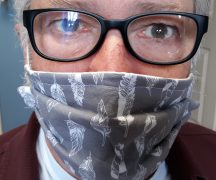By JAN LARSON McLAUGHLIN
BG Independent News
Coronavirus is now on every continent except Antarctica. No cases have been reported in Ohio, but some local residents are stocking up, just in case.
In Bowling Green, all the face masks have been sold out at Home Depot. The store was selling one mask per customer – not allowing bulk purchases. But those are all gone, and Home Depot has not been told when more will be shipped to the store.
At Ace Hardware, as of Friday afternoon, all the face masks were gone except two.
“We’re running low,” Ace associate Viri Henry said.
No one was buying the masks in bulk, but many people were coming in for one or two masks.
Once the masks are gone from the shelves, stores will not be replenished since the warehoused stocks are in great demand at hospitals.
Stores like Ace are being told it could be at least a couple months till face masks will be shipped out to stores again.
“They’re all running low,” Henry said.
This rush on face masks is non-productive, according to public health officials.
U.S. Surgeon General Dr. Jerome Adams posted a message on Twitter Saturday in response to face mask shortages as people stocked up due to coronavirus concerns.
“Seriously people … STOP BUYING MASKS!”
“They are not effective in preventing general public from catching #Coronavirus, but if healthcare providers can’t get them to care for sick patients, it puts them and our communities at risk,” Adams tweeted.
The advice from the Wood County Health Department is similar.
“Right now, there’s not a need to wear face masks in the public,” said Alex Aspacher, community outreach coordinator at the health department. “The real people who should be wearing masks are people who are sick.”
Instead, public health officials are advising that people wash their hands, stay home when sick, and get a flu shot, since fewer flu patients means more resources to fight the coronavirus.
“We want people to not be scared, but be prepared,” Wood County Health Commissioner Ben Batey said of the coronavirus, also called COVID-19.
“People should be more concerned about influenza that is circulating through Wood County,” Batey said. “We’re going to be promoting the same precautions we always have.”
The Wood County Health Department is participating in regular meetings, getting frequent updates from the Ohio Department of Health and Centers for Disease Control.
“We do this on a daily basis,” Batey said. “We want to make sure we are more than amply ready to respond.”
An email was sent out Friday to BGSU students, faculty and staff from Joe B. Whitehead Jr., provost and senior vice president for academic affairs at BGSU.
At the direction of Gov. Mike DeWine and based on guidance from the CDC, BGSU is prohibiting all university-supported travel to countries where the CDC has issued a Level 3 travel advisory to avoid non-essential travel. That prohibition currently includes mainland China, Iran, Italy and South Korea, and it is effective immediately.
BGSU also is taking the additional precaution of temporarily suspending planned study abroad programs and other university-supported group travel to countries under a CDC level 2 advisory – right now just Japan – through March 31.
BGSU will continue to monitor the situation in other parts of the world, particularly areas that host or will host education abroad programs or where faculty and staff plan to visit on university business.
Students, faculty and staff were advised to get flu shots, since the flu poses a bigger greater threat to Ohioans right now.
The email said if coronavirus cases appear at BGSU, the university has plans and protocols in place to manage the situation.
The Wood County Health Department is working with schools throughout the county, Aspacher said.
“This is something that’s not going away in a couple weeks,” he said. “We’re doing a lot of preparedness on the front end.”
Federal cuts to public health funding do have Batey concerned.
“I’m a huge supporter of public health funding,” he said. “It always makes more sense to fund prevention efforts than treat disease after it gets here.”
So funding cuts are especially a concern now, Batey said.
“We know how much we have to stretch our dollars to do what we already do.” Dealing with a pandemic will require much more, he said.
The Ohio Department of Health lists the following precautions for all infectious diseases:
- Stay home when sick.
- Avoid contact with people who are sick.
- Get adequate sleep and eat well-balanced meals.
- Wash hands often with soap and water, 20 seconds or longer.
- Dry hands with a clean towel or air dryer.
- Cover your mouth with a tissue or sleeve when coughing or sneezing.
- Avoid touching your eyes, nose or mouth with unwashed hands after touching surfaces.
- Clean and disinfect “high touch” surfaces after.
- Practice good hygiene habits.
Following is further information on the coronavirus:
Symptoms
Coronavirus makes people sick, usually with a mild to moderate upper respiratory tract illness, similar to a common cold. Its symptoms include a runny nose, cough, sore throat, headache and a fever that can last for a couple of days.
How does it spread
Transmission between humans happens when someone comes into contact with an infected person’s secretions, such as droplets in a cough.
Depending on how virulent the virus is, a cough, sneeze or handshake could cause exposure. The virus can also be transmitted by coming into contact with something an infected person has touched and then touching your mouth, nose or eyes.
How is it treated
There is no specific antiviral treatment, but research is underway.
Most of the time, symptoms will go away on their own and experts advise seeking care early. People who think they may have been exposed to the virus should contact their healthcare provider immediately.
How long is the incubation period
For coronavirus, the period of quarantine is 14 days from the last date of exposure.
How can you can prevent it
There is no vaccine to protect against it. The US National Institutes of Health is working on a vaccine but it will be months until clinical trials get underway and more than a year until it might become available.
Further information can be found on the Wood County Health Department Facebook page or from the CDC at https://www.cdc.gov/coronavirus/2019-ncov/index.html.





